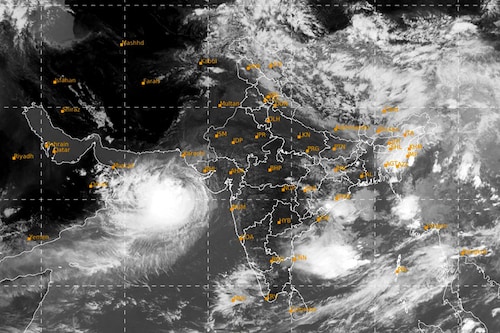Explained: All you need to know about Cyclone Biparjoy
As the storm prepares to make landfall on the western coast tomorrow, here's a primer on why there has been an uptick in cyclonic activity in the region of late


Cyclone Biparjoy is the second major cyclone in the north Indian Ocean region after Mocha, which struck the coastlines of Bangladesh and Myanmar on May 15. Not a very good sign, the experts say. ‘Very severe cyclone" Biparjoy is aiming at the coastline of Gujarat and Pakistan’s southern Sindh region from the Arabian Sea. It is expected to cross between Gujarat’s Mandvi and Pakistan’s Karachi near Jakhau Port in Gujarat on the evening of June 15. According to the India Meteorological Department (IMD), the cyclone will arrive with a maximum wind speed of 125–135 kmph, gusting to 150 kmph.
"This is an exceptional storm that will possibly strike with fury. Though it may drop its card to a serious storm at the time of landfall because of fiction, dry air entrainment, and a drop in temperatures," explains Sharma.
Due to extreme weather conditions caused by the incoming cyclone, seven people have died in India so far. Just yesterday, in Mumbai, three boys, who went missing after venturing near the turbulent Arabian Sea off Mumbai’s Juhu Koliwada, were found dead.
"In 2019, there were a total of nine storms in a year. On average, one should expect three storms. Most of the storms in the Arabian Sea drag away from the coast. Cyclone Biparjoy is an exception. We have already seen two cyclones this year the last one was Mocha in the Bay of Bengal. Temperature is the main ingredient for the development of a cyclonic storm," says Sharma of Skymet.
Cyclones are increasing both on the west and east coasts. Traditionally, the West Coast has not had cyclones to this extent, at least not major cyclones, explains environmentalist Sumaira Abdulali. "It"s a local as well as a global phenomenon, and cities are the most to blame. We should not expect that cities are going to escape the consequences of their actions forever. Right now, the actions are more visible in rural areas, and cities like Mumbai have escaped. But this will not be the case forever.
“The cyclone that happened in 2020 was the first to come this close to Mumbai in more than 100 years, and now it"s happening every year. So, it is going to strike at some point," she adds.
Also Read:
> How escalating climate events threatens food security across the globe
> Cyclones and the pressing concern for India"s western coast
First Published: Jun 14, 2023, 17:36
Subscribe Now